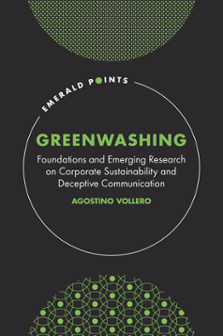Greenwashing

Foundations and Emerging Research on Corporate Sustainability and Deceptive Communication
Synopsis
Table of contents
(8 chapters)Abstract
The chapter begins the analysis by showing how the wider concept of ethical behaviour in organisations can be considered as the starting point to interpret the rise of environmental concerns in business operations as well as of greenwashing, primarily seen as a form of business misconduct. The focus on corporate environmentalism, intended as the deliberate process by which companies assimilate environmental concerns into their decision-making, provides the proper background to examine the birth of the concept of greenwashing. The discussion about ever-growing ethical issues, such as the conflict between private gain and public good, the tension between moral principles and profits, intertwines with the discourse on corporate sustainability and corporate social responsibility. Specifically, a distinction is made between mandatory and voluntary CSR disclosures, with the aim of elucidating further reasons behind greenwashing temptations. Lastly, the chapter concludes with the discussion of deceptive communication activities of companies that are described as different forms of identity-washing.
Abstract
The chapter describes the research objectives and different steps of the systematic literature review of existing studies on greenwashing. Both academics and practitioners may find this literature review useful, as it identifies the key features of the greenwashing research in a wide range of disciplines (management, marketing, accounting, corporate communication, etc.). The systematic literature review sheds light on the greenwashing types (and research gaps) in which the phenomenon takes shape. Time horizon (1990–mid 2021), keywords selection for queries on academic search engines, data collection, filtering criteria, etc., are explained and discussed in detail before presenting the main results in terms of frequency of publications over years, leading outlets in greenwashing research, trending articles, levels of analysis, geographical affiliation of first authors, theoretical approaches and methods used in this field of research. The chapter concludes by summarising the main types of greenwashing and possible avenues of research.
Abstract
The chapter explores how different theoretical traditions address the gaps between talk (symbolic communication practices) and actions (substantive performance) in organisations. The chapter details the main theoretical approaches in greenwashing research, namely legitimacy theory, attribution theory, institutional theory, signaling theory, impression management approaches and constructivist approaches. Among these latter, Communicative Constitution of Organizations (CCO) challenges the dominant view in literature and suggests abandoning the traditional dichotomy of talk versus action. The different approaches to studying greenwashing are presented along with main questions and research methods used in each field and sub-field of study. For each theoretical approach the main research trends and novel research questions are proposed. Researchers, doctoral and post-graduate students may appreciate this as standalone contribution to guide their future studies in this area, by designing their research avenues based on the best practices in the field.
Abstract
The chapter aims to bridge theory-practice by proposing an in-depth examination of three cases of companies accused of greenwashing, namely Volkswagen for Dieselgate, Nestlè and Golden Agri-Resources (a palm oil plantation company included in DJSI). The chapter thus reflects on deliberate communicative practices and organisational processes that lie beyond the most visible manifestations of greenwashing. Drawing on these cases, common communication errors and practices of corporate misconduct in corporate sustainability are disclosed. Readers, such as practitioners, who are not interested in academic mechanisms and more in the practical effects of the phenomenon can appreciate the analysis of the cases linked with the presentation of a series of principles and guidelines. Managerial solutions to contrast the different types of greenwashing risks, and to reduce associated negative effects on corporate image and reputation, are presented.
Abstract
This final chapter moves from a firm-level perspective to a more general level to connect individual organisational decisions on corporate sustainability to current and future societal and environmental challenges. The chapter starts by illustrating greenhushing, seen as a deceptive strategic silence that occurs when companies voluntarily decrease their communication on sustainability issues. The emergence of novel forms of greenwashing stresses the need to integrate the principles of sustainability in their corporate strategies in an authentic way, and to activate a virtuous circuit of sustainability sensegiving-sensemaking, in which the company can recognise the contribution of stakeholders in decision-making. The discussion then addresses some unresolved tensions in sustainability communication approaches that cause ‘deep-rooted’ greenwashing, thus paving the way for a systemic approach to the phenomenon. The chapter thus presents some speculative sketches that illustrate the social, organisational and environmental costs and benefits of an authentic approach to corporate sustainability. The discussion emphasises the need to establish a shared sustainability culture at different systems' levels and within organisations to avoid environmental and social damaging practices and widen corporate objectives to initiate long-lasting changes. Policy and decision-makers may appreciate this effort to identify responsibilities for each component and priority areas for action.

- DOI
- 10.1108/9781801179669
- Publication date
- 2022-05-23
-
- ISBN
- 978-1-80117-967-6
- eISBN
- 978-1-80117-966-9